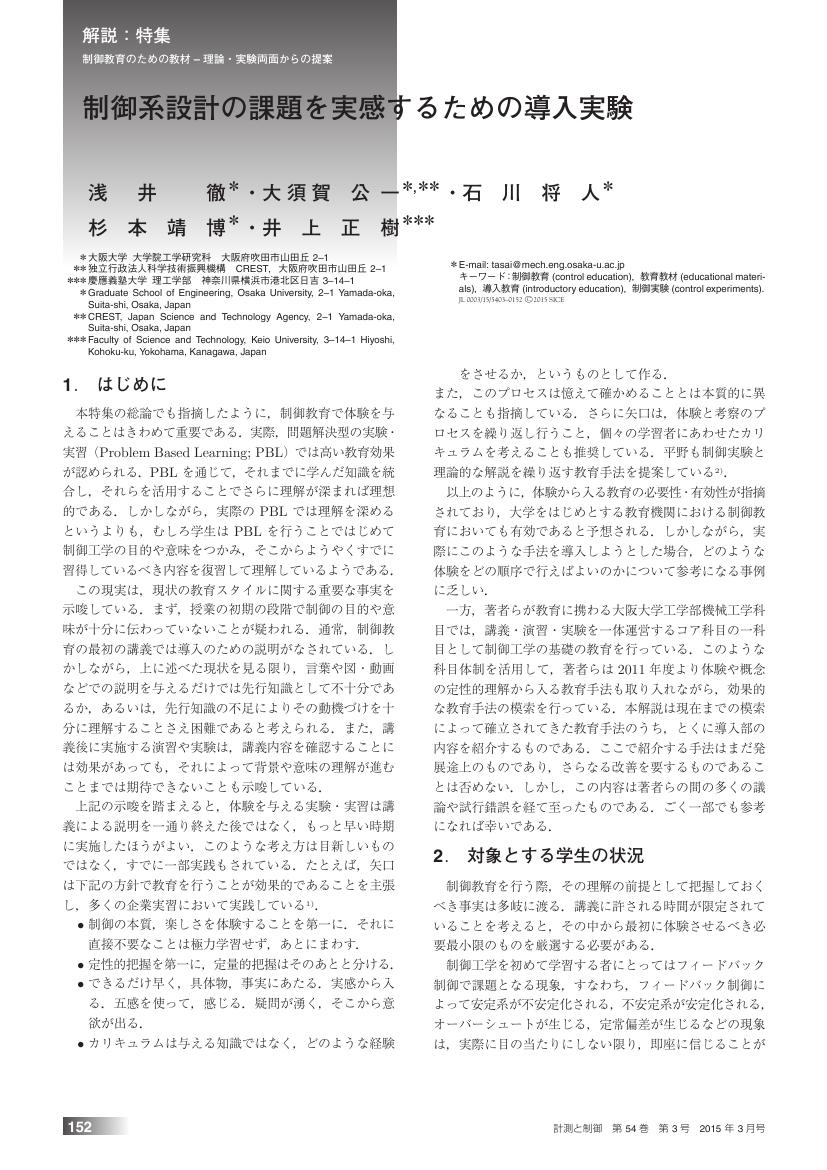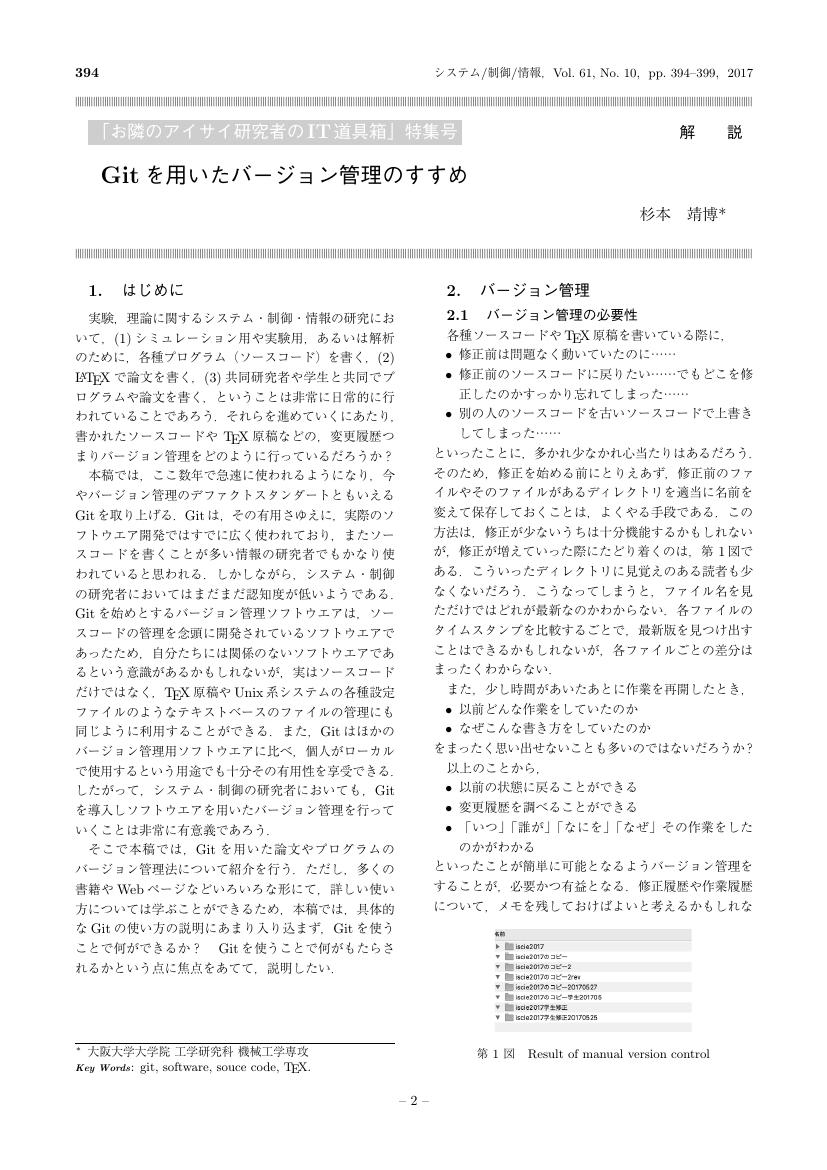31 0 0 0 OA 昆虫のゾンビ化から紐解く生物の多様な振る舞いの源泉
本研究の「要」は,昆虫の脳(中心体)に薬剤を注入することによって脳機能と下部神経系との情報のやり取りを遮断する「ゾンビ化」であるので,研究期間の前半は,1)昆虫のゾンビ化手法の確立,2)ゾンビ化昆虫のゾンビ化程度の検証法確立,に注力した.同時に,それらのゾンビ化手法が確立した後のために,3)昆虫の適応的運動能力の発現メカニズムの同定手法理論の検討,4)高度な脳機能を持たない運動制御原理の考察,を行なった.以下,進捗状況を説明する.1)昆虫のゾンビ化手法の確立:コオロギの脳内の薬剤投与部位をより厳密に制御するため,頭部の3Dマップに埋め込むための「コオロギ標準脳の作成を進めており,約60%程度進捗した.また,ゾンビ化システム」の構築を完了した.2)ゾンビ化昆虫のゾンビ化程度の検証法確立:「ゾンビコオロギ」はどのような振る舞いがみられるのかを確認するために,二種類の運動解析装置を試作中であり,70%程度完成した.さらに多様な環境を再現できるような球状トレッドミルシステムも開発した.また,頭部のないコオロギの振る舞いや,各部神経接続を外科的に切断したコオロギの振る舞いを確認している.3)昆虫の適応的運動能力の発現メカニズムの同定手法理論の検討:ゾンビコオロギが完成するまでの基礎研究として,一般の昆虫が示す適応能力の中でも特に,a)歩行速度への適応,b)脚切断への適応,c)環境への適応という三つの適応的な振る舞いに着目し,これら能力を発現しうる制御メカニズムのミニマルモデルの構築を目的とした研究を行った.4)高度な脳機能を用いない運動制御原理の考察:ゾンビ化された昆虫と同じく高度な脳機能をもたない脚機構が,環境/身体間および身体内の脚間で調和のとれた運動を生成する制御モデルを構築した.
31 0 0 0 OA 制御系設計の課題を実感するための導入実験
- 著者
- 浅井 徹 大須賀 公一 石川 将人 杉本 靖博 井上 正樹
- 出版者
- 公益社団法人 計測自動制御学会
- 雑誌
- 計測と制御 (ISSN:04534662)
- 巻号頁・発行日
- vol.54, no.3, pp.152-158, 2015-03-10 (Released:2015-05-26)
- 参考文献数
- 7
- 被引用文献数
- 1
3 0 0 0 OA Gitを用いたバージョン管理のすすめ
- 著者
- 杉本 靖博
- 出版者
- 一般社団法人 システム制御情報学会
- 雑誌
- システム/制御/情報 (ISSN:09161600)
- 巻号頁・発行日
- vol.61, no.10, pp.394-399, 2017-10-15 (Released:2018-04-15)
- 参考文献数
- 12
3 0 0 0 OA 制御系に埋め込まれた陰的制御則が適応機能の鍵を握る!?
- 著者
- 大須賀 公一 石黒 章夫 鄭 心知 杉本 靖博 大脇 大
- 出版者
- 一般社団法人 日本ロボット学会
- 雑誌
- 日本ロボット学会誌 (ISSN:02891824)
- 巻号頁・発行日
- vol.28, no.4, pp.491-502, 2010 (Released:2012-01-25)
- 参考文献数
- 24
- 被引用文献数
- 7 11
In this note, we consider a control system that underlies in a biological system. We point out the existence of the Problem of Inseparability in the control system. To understand the principle of mobile adaptability embedded in the control system, we have to solve the Problem of Indivisibility. To solve the problem, we propose a concept of Implicit control law. Finally, we show the Implicit control law plays an important role for constructing the adaptive function of living thing and robot.
2 0 0 0 コオロギゾンビ化のための頭部薬剤注入システム
- 著者
- 杉本 靖博 浪花 啓右 青沼 仁志 大須賀 公一
- 出版者
- 一般社団法人 日本機械学会
- 雑誌
- ロボティクス・メカトロニクス講演会講演概要集
- 巻号頁・発行日
- vol.2019, pp.2P2-F01, 2019
<p>Research that attempts to elucidate adaptive gait realization mechanism is underway through walking experiment with zombified crickets, based on the interesting behavior of <i>Ampulex compressa</i>. In this research, it is important to prepare a large number of experimental individuals with the same quality (degree of zombification). In this study, we developed a new system to support and semi-automate the injection for cricket zombification. The developed system consists of two cameras, micromanipulator and syringe pump and these devices are operated from PC in order to inject the injection needle at the same position and depth and inject the same amount of liquid medicine. The validity and practicality of the developed system were confirmed by verification experiments.</p>
1 0 0 0 超多脚型受動的動歩行の実現
- 著者
- 杉本 靖博 吉岡 秀隆 大須賀 公一
- 出版者
- The Robotics Society of Japan
- 雑誌
- 日本ロボット学会誌 (ISSN:02891824)
- 巻号頁・発行日
- vol.28, no.8, pp.961-969, 2010-10-15
- 参考文献数
- 15
- 被引用文献数
- 2 3
A passive dynamic walking robot can walk down a gentle slope naturally without any actuator or controller, only by potential energy. Therefore, it is thought that the principle of walking exists in this phenomenon. By current researches, the passive dynamic walking has been confirmed for two and four. However, it seems that it is also important to study passive dynamic walking for more than 6 legs because there are many creatures that have more than 6 legs. In this research, a passive dynamic walking robot with more than six legs was analyzed by a simulator. As a result, it was confirmed that passive dynamic walking even for 20 legs could be achieved. Furthermore, its gait could be changed by changing the body structure. In addition, the differences of stability depend on the number of legs resulted, and this differences disappeared by changing the position of the pitch spin parts. Moreover, its stability was very high, so it could walk on the contoured ground.
1 0 0 0 OA 環境に応じて形態制御する車輪型移動ロボットの開発
1 0 0 0 OA 超多脚型受動的動歩行の実現
- 著者
- 杉本 靖博 吉岡 秀隆 大須賀 公一
- 出版者
- 一般社団法人 日本ロボット学会
- 雑誌
- 日本ロボット学会誌 (ISSN:02891824)
- 巻号頁・発行日
- vol.28, no.8, pp.961-969, 2010 (Released:2012-01-25)
- 参考文献数
- 15
- 被引用文献数
- 3 3
A passive dynamic walking robot can walk down a gentle slope naturally without any actuator or controller, only by potential energy. Therefore, it is thought that the principle of walking exists in this phenomenon. By current researches, the passive dynamic walking has been confirmed for two and four. However, it seems that it is also important to study passive dynamic walking for more than 6 legs because there are many creatures that have more than 6 legs. In this research, a passive dynamic walking robot with more than six legs was analyzed by a simulator. As a result, it was confirmed that passive dynamic walking even for 20 legs could be achieved. Furthermore, its gait could be changed by changing the body structure. In addition, the differences of stability depend on the number of legs resulted, and this differences disappeared by changing the position of the pitch spin parts. Moreover, its stability was very high, so it could walk on the contoured ground.
1 0 0 0 アギトアリ顎部の高速運動を生む関節構造の立体模型を用いた解析
- 著者
- 和田 啓雅 杉本 靖博 青沼 仁志 浪花 啓右 大須賀 公一
- 出版者
- 一般社団法人 日本機械学会
- 雑誌
- ロボティクス・メカトロニクス講演会講演概要集
- 巻号頁・発行日
- vol.2018, pp.2P1-D12, 2018
<p>The trap-jaw ant genus <i>Odontomachus</i> closes her mandible to catch prey quite quickly. The purpose of this study is to examine the mechanism how such a fast movement is realized. Since the velocity of closing exceeds the contraction velocity of a muscle, it is considered that there will be a mechanism to store energy and release it at once for realization of high-speed motion in the exoskeleton. We prepare a scale model of Odontomachus with micro CT scanning their exoskeleton data and 3D printer. Using model, we find three regions of contact points of the temporomandibular joint and the exoskeletal part meshes with each other at one of the regions. This structure is considered to be related to a lock mechanism for fast movement of Odontomachus.</p>
1 0 0 0 多脚受動的動歩行ロボットが示すもの
- 著者
- 杉本 靖博 吉岡 秀隆 大須賀 公一
- 出版者
- The Japan Joint Automatic Control Conference
- 雑誌
- 自動制御連合講演会講演論文集
- 巻号頁・発行日
- vol.53, pp.129-129, 2010
これまでの受動的動歩行の研究では,二脚のロボットが対象とされてきたが,四脚以上の脚を持つ生物は非常に多く存在しており,それら生物の歩容と受動的動歩行との関連性を明らかにすることは非常に興味深いと考えられる.そこで本研究では,多脚(4脚あるいはそれ以上の脚)を持つ受動的動歩行を対象に,その実現可能性や多脚受動的動歩行ロボットが示す様々な歩容についての考察を行う.
1 0 0 0 OA 自律分散ロボット群による障害物クラスタ形成の解析と制御
- 著者
- 末岡 裕一郎 北 卓人 石川 将人 杉本 靖博 大須賀 公一
- 出版者
- 一般社団法人 日本機械学会
- 雑誌
- 日本機械学会論文集C編 (ISSN:18848354)
- 巻号頁・発行日
- vol.79, no.801, pp.1718-1727, 2013 (Released:2013-05-25)
- 参考文献数
- 15
- 被引用文献数
- 2 2
In this paper, we discuss some phenomena of obstacle clustering by distributed autonomous robots, in the light of space-discretization (or cellular automata) approach. This work was motivated by Swiss Robots which collect scattered obstacles into some clusters without any global information nor intelligent concentrated controller. Then we define fundamental event rules in this cellular world, and introduce two types of local rules for robot action: one is the Push & Turn rule, which can collect obstacles, the other is Pull & Turn rule, which can scatter obstacles. By defining several indices (ratio of immobile obstacles, ratio of moved obstacles), we investigate the dynamic equilibrium of obstacle clustering by heterogeneous agents. And, this paper also presents a control method of ratio of immobile obstacles from the estimation of each robot's local information even if all the states of obstacles cannot be measured.

